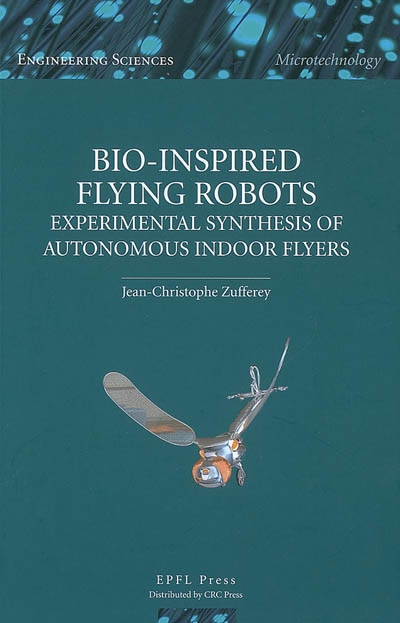en savoir plus

Permet à tous ses détenteurs d'obtenir 5% de réduction sur tous les livres lors du retrait en magasin (réduction non cumulable avec les réductions de type étudiant).
Offre également un certain nombre d'avantages auprès de nos partenaires.
Avec les favoris, retrouvez dans un espace les sélections effectuées au fur et à mesure de vos navigations dans le site.
Constituez pour votre usage personnel vos listes de livres en prévisions d'achats futurs et votre sélection d'articles, dossiers, événements, vidéos ou podcasts préférés ou à découvrir plus tard...
Il suffit simplement de cliquer sur "Ajout Favori" sur chaque page qui vous intéresse pour les retrouver ensuite dans votre espace personnel.
Requiert un compte Mollat
Requiert un compte Mollat
Bio-inspired flying robots : experimental synthesis of autonomous indoors flyers
Auteur : Jean-Christophe Zufferey
en savoir plus
Résumé
Une présentation de prototypes de robots volants inspirés de la morphologie des insectes: prototypage, essais de laboratoires, plates-formes robotiques, ingénierie optique, contrôle en vol. Un chapitre est consacré à la physiologie et l'anatomie des insectes. ©Electre 2025
Quatrième de couverture
This book demonstrates how bio-inspiration can lead to fully autonomous flying robots without relaying on external aids. Most existing aerial robots fly in open skies, far from obstacles, and rely on external beacons - mainly GPS - to localize and navigate. However, these robots are not able to fly at low altitude or in confined environments, and yet this poses absolutely no difficulty to insects. Indeed, flying insects display efficient flight control capabilities in complex environments despite their limited weight and relatively tiny brain size.
From sensor suite to control strategies, the literature on flying insects is reviewed from an engineering perspective in order to extract useful principles that are then applied to the synthesis of artificial indoor flyers. Artificial evolution is also utilized to search for alternative control systems and behaviours that match the constraints of small flying robots. Specifically, the basic sensory modalities of insects, vision, gyroscopes and airflow sense, are applied to develop navigation controllers for indoor flying robots. These robots are capable of mapping sensor information onto actuator commands in real time to maintain altitude, stabilize the course and avoid obstacles. The most prominent result of this novel approach is a 10-gram microflyer capable of fully autonomous operation in an office-sized room using fly-inspired vision, inertial and airspeed sensors.
This book is intended for all those interested in the autonomous robotics, working both in academic and industrial settings.
Fiche Technique
Paru le : 03/07/2008
Thématique : Physique générale Automatique
Auteur(s) : Auteur : Jean-Christophe Zufferey
Éditeur(s) :
EPFL Press
Collection(s) : Engineering Sciences
Série(s) : Non précisé.
ISBN : 978-1-4200-6684-5
EAN13 : 9781420066845
Reliure : Cartonné
Pages : XIV-205
Hauteur: 25.0 cm / Largeur 17.0 cm
Poids: 0 g

